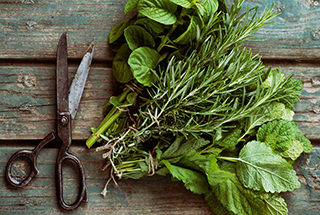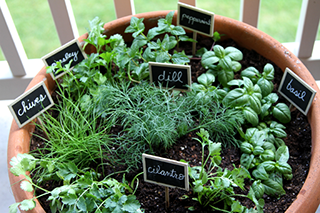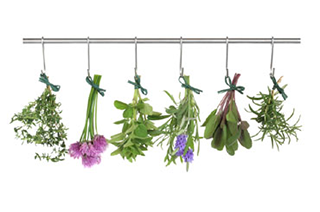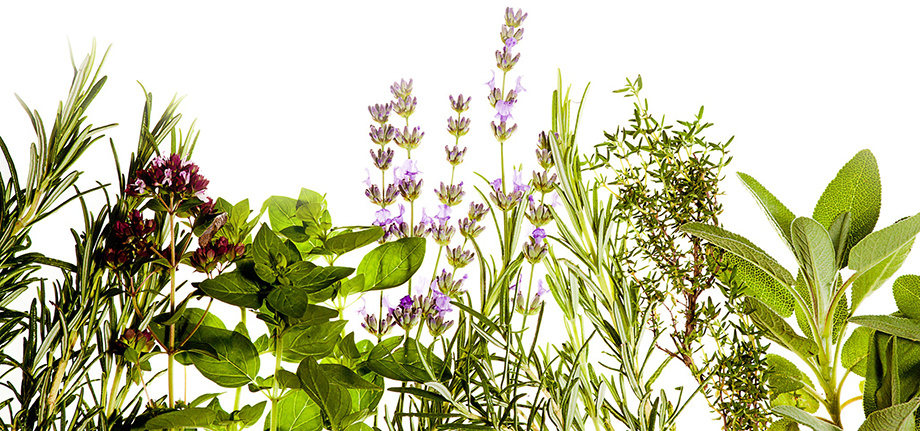 Basil: One of the most popular culinary herbs, sweet basil is used to make pesto, in sauces, sandwiches, soups and salads. Basic is typically paired with tomatoes with the delicious dish prepared with tomatoes, buffalo mozzarella, basil and good quality olive oil.
Basil: One of the most popular culinary herbs, sweet basil is used to make pesto, in sauces, sandwiches, soups and salads. Basic is typically paired with tomatoes with the delicious dish prepared with tomatoes, buffalo mozzarella, basil and good quality olive oil.
Mint: An extremely versatile herb, mint is a brilliant combination with lamb while often being used with fruit and vegetable dishes. Can be used in dishes such as lamb, peas, carrots, ice-cream, mint juleps and mojitos.
Rosemary: In latin, rosemary is translated as “dew of the sea” and is indigenous to the Mediterranean. Rosemary is by far one of the most aromatic herbs with a strong lemon-pine flavour. It is in harmony with lamb, garlic and olive oil. Rosemary is also delicious with focaccia, tomato sauce, pizza and pork. Use sparingly due to its pugnacity.
Oregano: With a name that means “joy of the mountain”, oregano grows wild in the mountains of Italy and Greece which is why the Greeks are said to love this herb sprinkled on salads while their Italian contemporaries have been using oregano on pizza and in tomato sauces for centuries. Add chopped oregano to poultry, game or seafood. Marjoram is similar in appearance but is sweeter and more delicate than the robust aroma of oregano.
Sprinkle or garnish your dish
 Thyme: Most chefs will use the French Thyme variety and is one of the most important herb of the kitchen. Often one of the chief ingredients in a bouquet garni and pairs well with other herbs such as rosemary, parsley, sage, and oregano. Its earthy flavour is welcome with pork, lamb or duck and is frequently used in Cajun and Creole cooking.
Thyme: Most chefs will use the French Thyme variety and is one of the most important herb of the kitchen. Often one of the chief ingredients in a bouquet garni and pairs well with other herbs such as rosemary, parsley, sage, and oregano. Its earthy flavour is welcome with pork, lamb or duck and is frequently used in Cajun and Creole cooking.
Coriander or Cilantro: However you choose to name this herb, its unique flavour is a staple in many Indonesian dishes with Middle Eastern cooking and Southern European food also coming to the coriander party. One of the more versatile herbs, it adds distinctive flavour to salsas, soups, stews, curries, salads, vegetable dishes, fish and chicken.
Parsley: This herb is celebrated by chefs everywhere and can go in just about everything. With a mild, grassy flavour it allows the tastes of other ingredients to shine. The flat-leaf variety is preferred for cooking due its ability to withstand high heat and with a stronger flavour. The decorative variety is used most for garnishing. To add a burst of colour or taste add it on roasted lamb, grilled steaks, fish, chicken or vegetables. Adding lemon or zest of garnish an osso bucco with.
Grow in your garden
 Chives: Chives make a fantastic addition to dips, quesadillas or on baked potatoes. It is a staple for potato salads and pairs well with eggs.
Chives: Chives make a fantastic addition to dips, quesadillas or on baked potatoes. It is a staple for potato salads and pairs well with eggs.
Dill: Since the ancient Roman times, dill has symbolised vitality. In the kitchen, its feathery leaves lend a fresh, sharp flavour to all kinds of dishes. Cottage cheese, cream cheese, goats’ cheese, omelettes, seafood, yoghurt and cucumber.
Sage: native to the northern Mediterranean it is used commonly in cooking there. The flavours of sage are redolent of eucalyptus, cedar, lemon and mint. Italians use it with veal, French put it in stuffing, cured meats, sausages and pork dishes. Americans use it with turkey and dressing.
Tarragon: Although this herb is a native of Siberia and parts of Western Asia, tarragon is frequently used in French dishes. It can be added to white wine vinegar, lending sweet, delicate licorice-like perfume and flavour. It marries well with fish, omelettes, and chicken, mustard and goes perfectly in béarnaise sauce. With a bittersweet, peppery taste it needs to be added at the end of cooking or as a garnish as cooking destroys the flavour.
If you want advice on cooking, need a caterer or a venue we are happy to help.



Leave A Comment